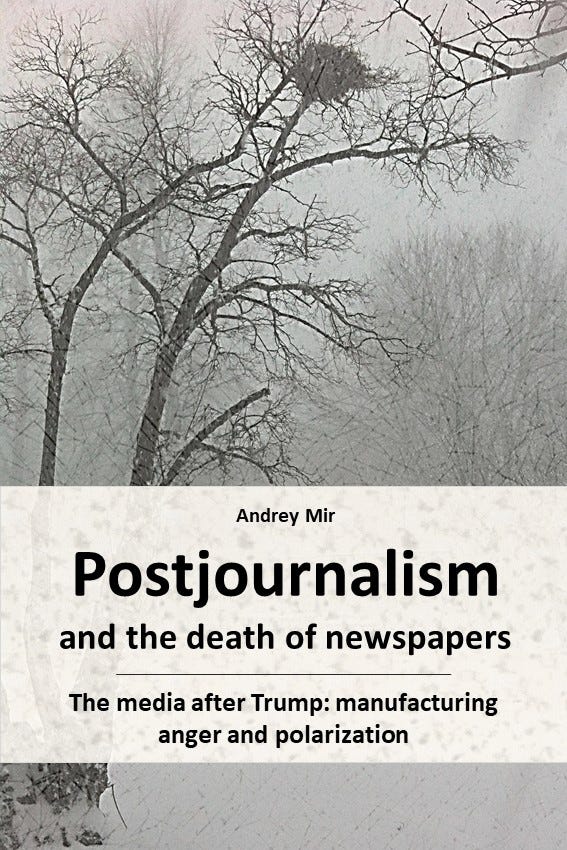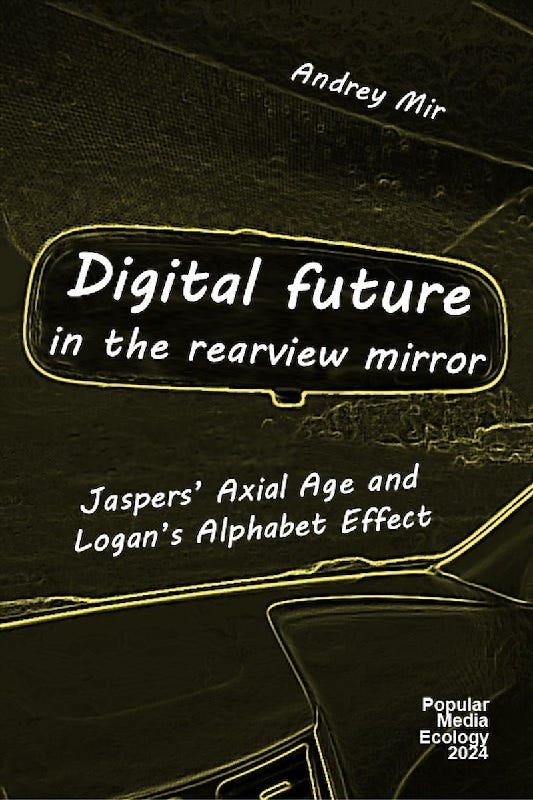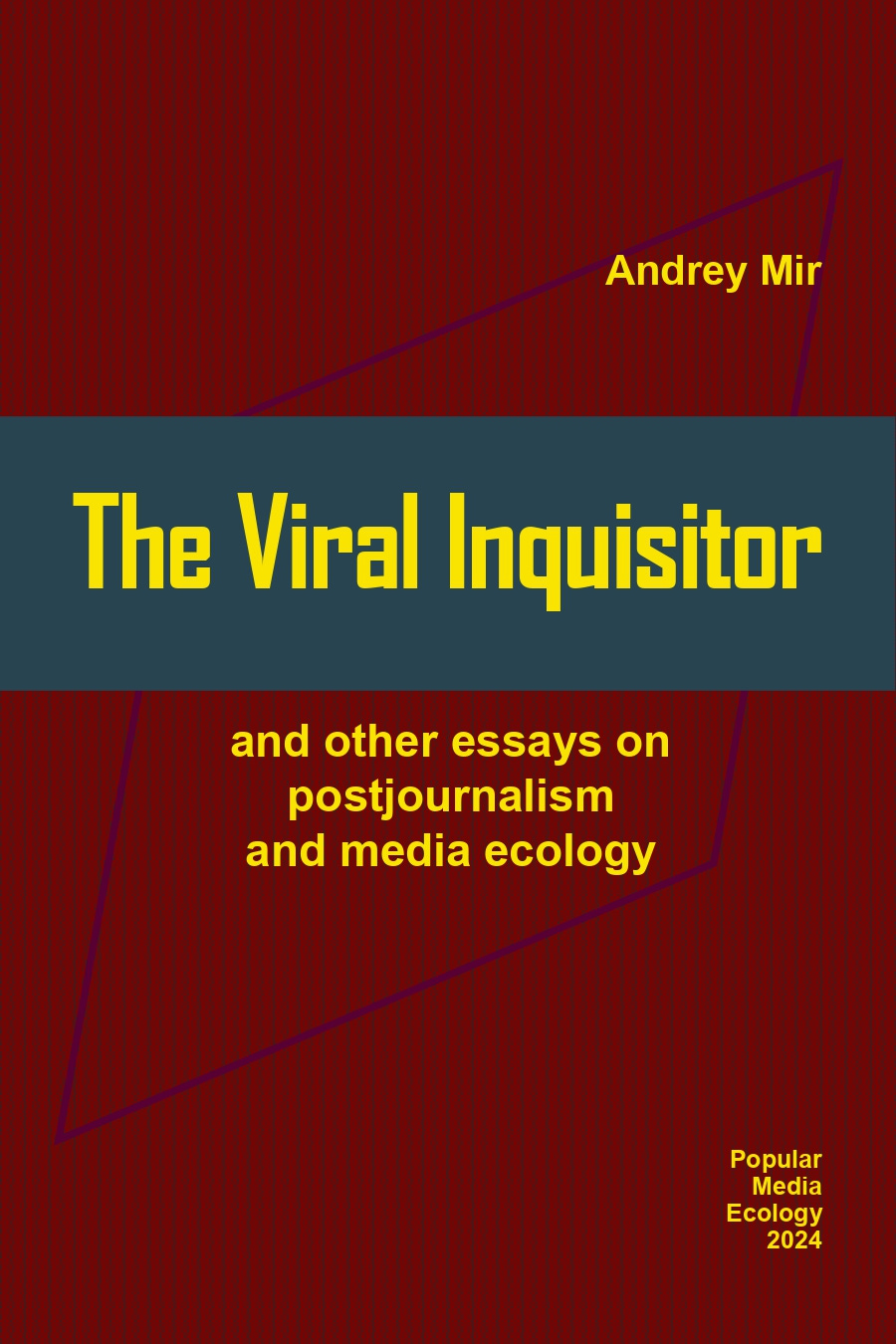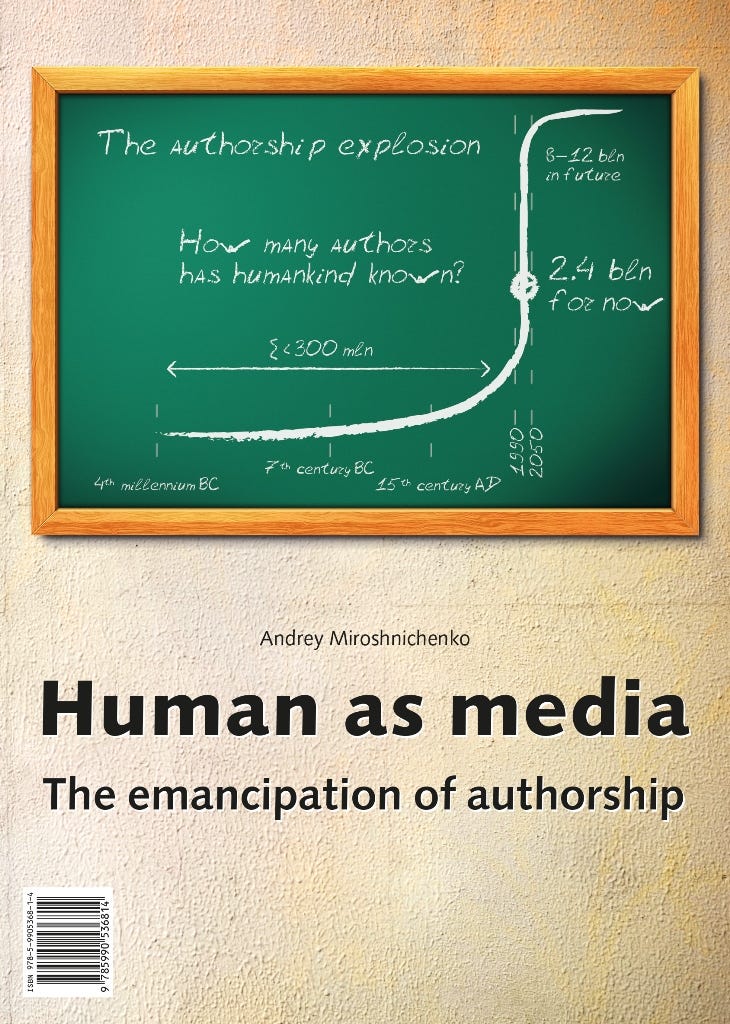Rage on social media: intensity instead of feelings
Intensity signaling is a built-in feature of social media that encourages socializing through rage
Postmodernist emotionality cannot afford silent or quiet emotional signaling – it must scream. This is how you discern feelings from intensities: feelings can be powerful without being loud, intensities cannot.
Exaggerated emotional signaling is one of the defining features of social media. Postjournalism makes its own contribution to hyping postmodernist intensities and the hysterical sublime.
A chapter from “Postjournalism and the death of newspapers. The media after Trump: manufacturing anger and polarization”
…In his analysis of postmodernist conditions, Frederic Jameson noted that deep feelings of modernity were replaced by intensities, as Jameson called it, following Lyotard. The ‘shared with others’ emotional intensities instead of personal deep feelings became one of the defining features of postmodernism.
This plays well with Deleuze’s concept of dividual as opposed to individual. In the postmodernist worldview, the individual was deconstructed into smaller features –dividuals, the markers of identity, such as being black or white, native or migrant, straight or gay, a gun owner or a Mac owner, etc. Unlike individuality, identity markers are not personal. They always represent belonging with a group; they are selectively shared features. But, from the postmodernist point of view, they may constitute the core of personality.
Identity markers began to usurp the larger political identifiers of the past. They now define and prescribe individual behavior much like social class once did.
Not only is dividual a new basis for identity formation, it also brings a new framework for both social unity and personal expression. But the expression of identity, paradoxically, is not individual. It is identic – shared with others who conspicuously stress having the same identity. The disintegration of individuality into dividuals for the purpose of identification aligns well with McLuhan’s idea of tribalization.
***
The Russian national-religious ethos favoured capitalizing on collective suffering, which explains the particular success of socialism there. The Protestant religious ethos prescribed capitalizing on individual success, which underlay Western democracies with their focus on human rights grown out of the bourgeois struggle for individual freedoms. Postmodernism and affiliated progressive movements have fused the Marxist admiration of social struggle with the bourgeois dogma of idividual rights into a new ethical hybrid that urges capitalizing on individual suffering.
More precisely, postmodernism eventually encouraged capitalizing on dividual suffering, or identity suffering. Reason being that what is displayed for identification and socialization in the conditions of late capitalism is a group-attested suffering identity, not the intrinsically controversial multifaceted individuality.
***
When the complex and contradictory individuality becomes reduced to the identity-based dividuality, former feelings become intensities, whose function is signaling rather than expressing.
The individual used to have a self and connect with others through self-expression. The identity is just an emphasized facet of the self. The identity gets expressed in prioritized displaying – signaling. Identity signaling becomes a dominant emotional function for identity recognition and acknowledgment.
As occurs within any environment flooded with signals, the overcoming of noise is the crucial factor in signal efficiency. Signals have to compete with each other and the noise. In modernist emotionality, feelings can allow themselves to be quiet and even silent. They are able to stay powerful regardless of the volume they are able to produce. Postmodernist emotionality cannot afford silent or quiet emotional signaling – it must scream. This is how you discern feelings from intensities: feelings can be powerful without being loud, whereas intensities cannot. Intensities are destined for the signaling of expected features to others, not expressing the complexity of self.
Exaggerated emotional signaling – Jameson-Lyotard’s “intensities” – is one of the defining features of social media.
***
The fragmentation of individuality down to identity markers caused a change in the kind of energy that fuels political activity. When the individual was at the center of the political sphere, rational ideas used to shape ideologies and ideologies were the foundation of political activity. In the postmodernist environment, ideologies are marginalized and emotions command the expression of the political.
It is becoming harder to define what ideology underlies the political stances of the left and the right in the postmodernist environment. But the stances of the left and the right can be sufficiently described through the senses of grievance and resentment respectively. Thus, intensities become a means of political struggle. Political activity has moved from debate towards rituals, the main form of which is signaling about opposing or endorsing a cause.
Fredric Jameson foresaw this move from rationality to emotionality and from feelings to intensities when he observed “a peculiar kind of euphoria”, “something like a camp or ‘hysterical’ sublime” as essential manifestations of postmodernism.
***
Intensities and intensities’ signalling are essential features of an environment in which users strive for response in pursuit of self-affirmation. Jameson explored the phenomenon of intensities instead of feelings mostly in arts. Social media created a perfect environment for the “democratization” of intensities and intensities’ signaling. Connected and struggling for affirmation, people display their identity markers as a form of currency for earning social capital; and since many compete in signaling, the overt noise makes them signal louder.
Another factor in intensities’ intensification on social media is the fact that social media allow people to freely express what is suppressed in the mainstream media intensities. The pressure difference amplifies agenda-setting polarization between old media and new media.
Polarized agendas make their way onto social media for further circulation and additionally increase rage and political polarization. For the majority on social media, as Martin Gurri noticed, “rage really is a rhetorical convention, like sonnet-writing for Elizabethan gentlemen.” He wrote:
Does the digital environment incentivize the rant? It would appear to do so. Amid the infernal howl of hundreds of millions of voices, you need to scream just to be heard. If you can also arouse a primal emotion like anger, you will attract more attention and so rise above other screamers.
Yes, in a crowded information environment, potent emotions are needed to give traction to any message. But why is rage the default? Ranters in their virtual war-bands are nothing like factory workers in Victorian England or black civil rights militants in the 1960s. They aren’t oppressed or marginalized. On the contrary, as a class they tend to be affluent, hyper-educated, and savvy in the ways of the web. They have few obvious reasons to be angry and can exploit different emotive techniques for their purposes.
Paradoxically, the social media environment has built-in settings that encourage socializing through rage. This is something normally unacceptable and strategically disadvantageous in offline social communication. Offline, rage would result, among other things, in physical consequences that correct behavior through the sensorium. But on social media, rage is not risky and can be beneficial.
The social media’s proclivity for rage poses a bigger threat than the usual suspects – such as trolls, bots, disinformation, or fake news – to which people are either barely susceptible or eventually able to develop immunity. The environmental demand for the amplification of intensities’ signaling is not received as a negative factor on social media. It entails neither repelling nor immunity; on the contrary, it stimulates engagement. For platform owners, it is a good thing, the bread and butter of business. The social media settings of signal intensification are both virally productive and socially toxic, as they enhance engagement but amplify rage and polarization.
***
Postjournalism has its own reason to join the shift from rationality to emotionality and peddling intensities’ signaling up to the hysterical sublime. If the media solicit donations (pretending it’s a subscription), they need to promote a donatable cause. Not only do they seek engagement and loyalty from the audience, they themselves also need to demonstrate loyalty and engagement. Impartiality will not succeed in soliciting for donations. The media have to proactively and intensively signal their endorsing or opposing stances. Emotional signaling becomes an important feature of the business plan, gradually suppressing the rational substantiations of why the cause endorsed is noble. Soliciting should be persuasive.
Technically, the rationale behind the cause is no longer needed if the media is savvy enough to merely find the right donatable cause and the right donating audience. Rationality is not a must for journalism – signaling intensities is.
Another intensifier of intensities’ signaling in the media is competition, which, again, creates noise and the necessity for this noise to be overcome. The news media have joined the same noise race that social media are in.
Intensities’ signaling is maintained even more so by the fear of negative feedback from the donating audience. Herman and Chomsky identified flak also as an emotional regulator of their Propaganda model. “Flak will tend to press the media to greater hysteria in the face of enemy evil,” they wrote.
Indeed, the flak of the donating audience does not bother as much with fact-checking as it does with purity-testing. Orwell’s Two Minutes Hate was a daily rite not so much for informing about the enemy, but for checking the fidelity of followers through observing whether they express their hate loudly enough.
Postjournalism, therefore, makes its own specific contribution to hyping postmodernist intensities and the hysterical sublime. Different aspects of postjournalism reinforce each other: the commodification of intensities aligns its ‘efforts’ with the work of negativity bias, flak, polarization, and activism of the media.
Excerpts from “Postjournalism and the death of newspapers. The media after Trump: manufacturing anger and polarization”
See also books by Andrey Mir:
The Viral Inquisitor and other essays on postjournalism and media ecology (2024)
Digital Future in the Rearview Mirror: Jaspers’ Axial Age and Logan’s Alphabet Effect (2024)









“The Superior Virtue of the Oppressed”, Bertrand Russell
[This essay was published by Bertrand Russell in 1937 in The Nation, 144. It was republished in Russell’s Unpopular Essays (1950). An online transcript of it is also here.]
https://criticathink.wordpress.com/2018/04/11/the-superior-virtue-of-the-oppressed-bertrand-russell/
A rather curious form of this admiration for groups to which the admirer does not belong is the belief in the superior virtue of the oppressed: subject nations, the poor, women, and children. The eighteenth century, while conquering America from the Indians, reducing the peasantry to the condition of pauper laborers, and introducing the cruelties of early industrialism, loved to sentimentalize about the “noble savage” and the “simple annals of the poor.” Virtue, it was said, was not to be found in courts: but court ladies could almost secure it by masquerading as shepherdesses. And as for the male sex:
Happy the man whose wish and care
A lew paternal acres bound.
Nevertheless, for himself Pope preferred London and his villa at Twickenham.